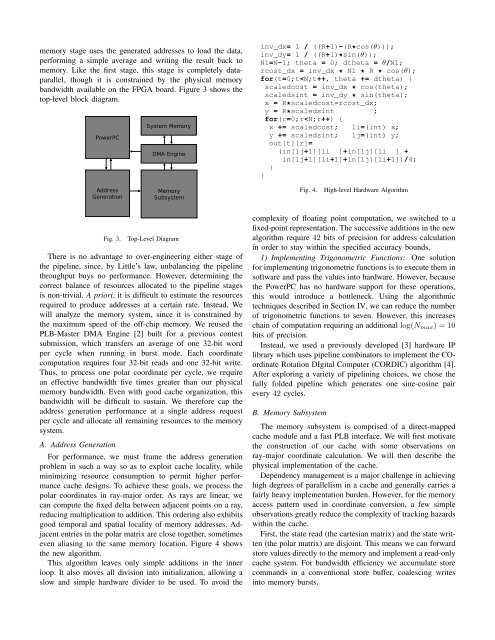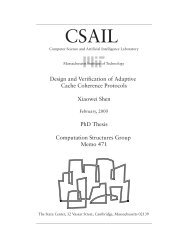Implementing a Fast Cartesian-Polar Matrix Interpolator - MIT
Implementing a Fast Cartesian-Polar Matrix Interpolator - MIT
Implementing a Fast Cartesian-Polar Matrix Interpolator - MIT
Create successful ePaper yourself
Turn your PDF publications into a flip-book with our unique Google optimized e-Paper software.
memory stage uses the generated addresses to load the data,<br />
performing a simple average and writing the result back to<br />
memory. Like the first stage, this stage is completely dataparallel,<br />
though it is constrained by the physical memory<br />
bandwidth available on the FPGA board. Figure 3 shows the<br />
top-level block diagram.<br />
PowerPC<br />
Address<br />
Generation<br />
System Memory<br />
DMA Engine<br />
Memory<br />
Subsystem<br />
Fig. 3. Top-Level Diagram<br />
There is no advantage to over-engineering either stage of<br />
the pipeline, since, by Little’s law, unbalancing the pipeline<br />
throughput buys no performance. However, determining the<br />
correct balance of resources allocated to the pipeline stages<br />
is non-trivial. A priori, it is difficult to estimate the resources<br />
required to produce addresses at a certain rate. Instead, We<br />
will analyze the memory system, since it is constrained by<br />
the maximum speed of the off-chip memory. We reused the<br />
PLB-Master DMA Engine [2] built for a previous contest<br />
submission, which transfers an average of one 32-bit word<br />
per cycle when running in burst mode. Each coordinate<br />
computation requires four 32-bit reads and one 32-bit write.<br />
Thus, to process one polar coordinate per cycle, we require<br />
an effective bandwidth five times greater than our physical<br />
memory bandwidth. Even with good cache organization, this<br />
bandwidth will be difficult to sustain. We therefore cap the<br />
address generation performance at a single address request<br />
per cycle and allocate all remaining resources to the memory<br />
system.<br />
A. Address Generation<br />
For performance, we must frame the address generation<br />
problem in such a way so as to exploit cache locality, while<br />
minimizing resource consumption to permit higher performance<br />
cache designs. To achieve these goals, we process the<br />
polar coordinates in ray-major order. As rays are linear, we<br />
can compute the fixed delta between adjacent points on a ray,<br />
reducing multiplication to addition. This ordering also exhibits<br />
good temporal and spatial locality of memory addresses. Adjacent<br />
entries in the polar matrix are close together, sometimes<br />
even aliasing to the same memory location. Figure 4 shows<br />
the new algorithm.<br />
This algorithm leaves only simple additions in the inner<br />
loop. It also moves all division into initialization, allowing a<br />
slow and simple hardware divider to be used. To avoid the<br />
inv_dx= 1 / ((R+1)-(R*cos(θ)));<br />
inv_dy= 1 / ((R+1)*sin(θ));<br />
N1=N-1; theta = 0; dtheta = θ/N1;<br />
rcost_dx = inv_dx * N1 * R * cos(θ);<br />
for(t=0;t
















